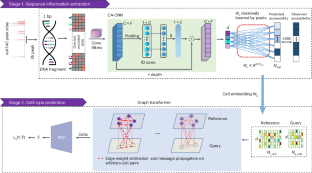SANGO efficiently removed batch effects between the query and reference single-cell ATAC signals through the underlying genome sequences, to enable cell type assignment according to the reference data. The method achieved superior performance on diverse datasets and could detect unknown tumor cells, providing valuable functional biological signals.
This is a preview of subscription content, access via your institution
Access options
Access Nature and 54 other Nature Portfolio journals
Get Nature+, our best-value online-access subscription
$29.99 / 30 days
cancel any time
Subscribe to this journal
Receive 12 digital issues and online access to articles
$99.00 per year
only $8.25 per issue
Buy this article
- Purchase on Springer Link
- Instant access to full article PDF
Prices may be subject to local taxes which are calculated during checkout

References
Satpathy, A. T. et al. Massively parallel single-cell chromatin landscapes of human immune cell development and intratumoral T cell exhaustion. Nat. Biotechnol. 37, 925–936 (2019). This paper reports the regulatory networks involved in human immune cell development and intratumoral T cell exhaustion at a large scale.
Chen, H. et al. Assessment of computational methods for the analysis of single-cell ATAC-seq data. Genome Biol. 20, 241 (2019). A review article that presents the challenges and computational methods for the analysis of single-cell ATAC-seq data.
Yuan, H. & Kelley, D. R. scBasset: sequence-based modeling of single-cell ATAC-seq using convolutional neural networks. Nat. Methods 19, 1088–1096 (2022). This paper reports scBasset, a widely used method for predicting chromatin accessibility from genomic sequence information.
Cui, H. et al. scGPT: toward building a foundation model for single-cell multi-omics using generative AI. Nat. Methods https://doi.org/10.1038/s41592-024-02201-0 (2024). This paper reports scGPT, a novel method pre-trained on a large number of datasets for single-cell data analysis.
Rao, J., Zheng, S., Lu, Y. & Yang, Y. Quantitative evaluation of explainable graph neural networks for molecular property prediction. Patterns 3, 100628 (2022). A review article that presents advances in explainable artificial intelligence research, summarizing various interpretability approaches.
Additional information
Publisher’s note Springer Nature remains neutral with regard to jurisdictional claims in published maps and institutional affiliations.
This is a summary of: Zeng, Y. et al. Deciphering cell types by integrating scATAC-seq data with genome sequences. Nat. Comput. Sci. https://doi.org/10.1038/s43588-024-00622-7 (2024).
Rights and permissions
About this article
Cite this article
Annotating cell types in single-cell ATAC data via the guidance of the underlying DNA sequences. Nat Comput Sci 4, 261–262 (2024). https://doi.org/10.1038/s43588-024-00626-3
Published:
Issue Date:
DOI: https://doi.org/10.1038/s43588-024-00626-3
